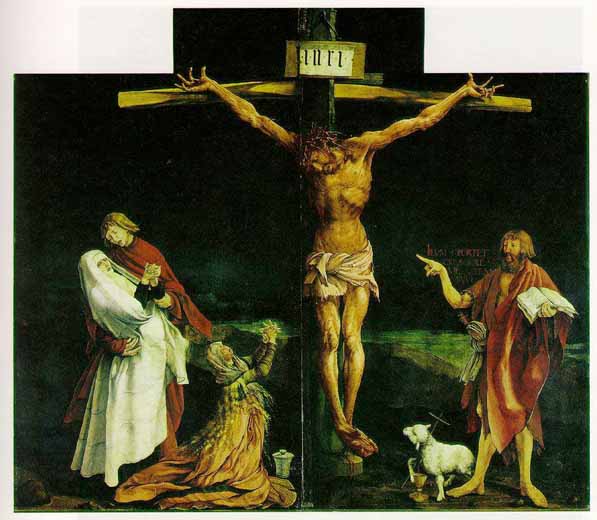Isenheimer Altar (1515)

The Crucifixion
1515
Oil on wood, 269 x 307 cm
Musée d'Unterlinden, Colmar
The picture shows a panel of the Isenheim Alterpiece.
The Isenheim Altarpiece was executed for the hospital chapel of Saint Anthony's Monastery in Isenheim in Alsace and is now at the Unterlinden Museum in Colmar, a nearby town. It is a carved shrine with two sets of folding wings and three views. The first, with the wings closed, is a Crucifixion showing a harrowingly detailed, twisted, and bloody figure of Christ on the cross in the center flanked, on the left, by the mourning Madonna being comforted by John the Apostle, and Mary Magdalene kneeling with hands clasped in prayer, and, on the right, by a standing John the Baptist pointing to the dying Savior. At the feet of the Baptist is a lamb holding a cross, symbol of the "Lamb of God" slaughtered for man's sins. The drama of the scene, symbolizing the divine and human natures of Christ, is heightened by the stark contrast between the vibrantly lit foreground and the dark sky and bleak landscape of low mountains in the background. When the outer wings are opened, three scenes of celebration are revealed: the Annunciation, the Angel Concert for Madonna and Child, and the Resurrection. Grünewald's unsurpassed technique in painting colored light is epitomized in the figure of the rising Christ; his dramatic use of writhing forms in movement is also seen here in the figures of Christ, the arriving angel, and the Madonna.
Art for him did not consist in the search for the hidden laws of beauty - for him it could have only one aim, the aim of all religious art in the Middle Ages - that of providing a sermon in pictures, of proclaiming the sacred truths as taught by the Church. The central panel of the Isenheim altarpiece shows that he sacrificed all other considerations to this one overriding aim. Of beauty, as the Italian artists saw it, there is none in the stark and cruel picture of the crucified Savior. Like a preacher at Passiontide, Grunewald left nothing undone to bring home to us the horrors of this scene of suffering: Christ's dying body is distorted by the torture of the cross; the thorns of the scourges stick in the festering wounds which cover the whole figure. The dark red blood forms a glaring contrast to the sickly green of the flesh. By His features and the impressive gesture of His hands, the Man of Sorrows speaks to us of the meaning of His Calvary. His suffering is reflected in the traditional group of Mary, in the garb of a widow, fainting in the arms of St John the Evangelist, to whose care the Lord has commended her, and in the smaller figure of St Mary Magdelene with her vessel of ointments, wringing her hands in sorrow. On the other side of the Cross, there stands the powerful figure of St John the Baptist with the ancient symbol of the lamb carrying the cross and pouring out its blood into the chalice of the Holy Communion. With a stern and commanding gesture he points towards the Savior, and over him are written the words that he speaks (according to the gospel of St John iii. 30): 'He must increase, but I must decrease.'
There is little doubt that the artist wanted the beholder of the altar to meditate on these words, which he emphasized so strongly by the pointing hand of St John the Baptist. Perhaps he even wanted us to see how Christ must grow and we diminish. For in this picture, in which reality seems to be depicted in all its unmitigated horror, there is one unreal and fantastic trait: the figures differ greatly in size. We need only compare the hands of St Mary Magdalene under the Cross with those of Christ to become fully aware of the astonishing difference in their dimensions. It is clear that in these matters Grunewald rejected the rules of modern art as it had developed since the Renaissance, and that he deliberately returned to the principles of medieval and primitive painters, who varied the size of their figures according to their importance in the picture. Just as he had sacrificed the pleasing kind of beauty for the sake of the spiritual lesson of the altar, he also disregarded the new demand for correct proportions, since this helped him to express the mystic truth of the words of St John.